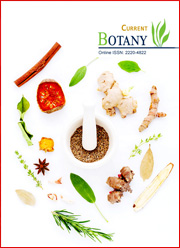Dyeing of cotton and silk fabric with Tradescantia spathacea Sw. leaf aqueous extract
DOI:
https://doi.org/10.25081/cb.2024.v15.9127Keywords:
Tradescantia spathacea, Natural dyes, Fastness test, Aqueous extract, Cotton fabricAbstract
Colour is one of the appealing factors that impress people across the world. In every living organism in this globe i.e., insect, bird, animal, plant and human etc., colour seems to be the most attractive factor throughout the life. The Tradescantia spathacea leaf extract was used for dyeing of cotton and silk fabric. The mordants used in this study were Copper Sulphate and Myrobalan. There were three methods of mordanting carried out in this study namely, simultaneous mordanting, pre-mordanting and post mordanting. In the dyed cotton fabric, pre-mordanting treatment with myrobalan (Grey Scale Rate 4) and Copper Sulphate (Grey Scale Rate 3) showed better grey scale rating than other treatments. The silk fabrics dyed with the leaf extract resulted in grey scale rating of 3-4 or 4 for wash fastness tests. This indicates that all the natural dye applied silk fabrics showed better response than cotton in retaining the dye after washing. In staining tests (the spilling of dye/colour from the natural dyed fabrics on other cotton and wool fabrics) almost all the treatments showed very good results. The grey scale rating of 4-5 was achieved for all the dyed fabrics. Since the fabric showed better results it can be further elaborated for large scale dyeing experiments and more fastness studies like fastness to light, ironing etc. for suitable application in textile dyeing of silk fabrics.
Downloads
References
Atienza, A. (2019). Dye Extracted from Boat Lily Plant (Tradescantia spathacea) Leaves and its Application to Jusi Silk Fabric. Ascendens Asia Journal of Multidisciplinary Research, 3(2), 1-3.
Broadbent, A. D. (2001). Basic Principles of Textile Coloration. West Yorkshire, UK: Society of Dyers and Colourists.
Jabli, M. (2018). Extraction of Eco-Friendly Natural Dyes from Tradescantia pallida Purpurea and Cynomorium coccineum Growing Naturally in Tunisia. Trends in Textile Engineering & Fashion Technology, 1(1), 4-7. https://doi.org/10.31031/tteft.2018.01.000502
Jue, J., & Ha, J. H. (2022). Exploring the relationships between personality and color preferences. Frontiers in Psychology, 13, 1065372. https://doi.org/10.3389/fpsyg.2022.1065372
Kannathasan, K., & Kokila, P. (2021). Dyeing of cotton fabric by Caesalpinia sappan aqueous extract at different temperatures and mordants. Current Botany, 12, 188-191. https://doi.org/10.25081/cb.2021.v12.7277
Khaing, A. M., Win, K. N., Maung, Y. M., & Win, T. T. (2019). Preparation and Optical Properties of some Natural Dyes (Ixora coccinea & Tradescantia spathacea). Journal of Myanmar Academy of Arts and Science, 17(2), 173-185.
Manzoor, J., & Sharma, M. (2020). Impact of textile dyes on human health and environment. In K. A. Wani, N. K. Jangid, A. R. Bhat (Eds.), Impact of Textile Dyes on Public Health and the Environment (pp. 162-169). Pennsylvania, United States: IGI Global. https://doi.org/10.4018/978-1-7998-0311-9.ch008
Miranda-Medina, A., García-Medel, P. L., Rodríguez-Martínez, K., Hayward-Jones, P. M., Barradas-Dermitz, D. M., Luna-Carrillo, G. (2023). Extraction Optimization of Tradescantia Spathacea Sw. Leaf Crude Extract and Anthocyanin Content. Chemistry & Chemical Engineering, Biotechnology, Food Industry, 24(1), 1-15.
Mukherjee, A., Maulik, S. R., Choudhury, P. K., & Mitra, A. (2005). Application of natural dyes in handloom sectors. Textile Trends, 48(3), 37-45.
Pizzicato, B., Pacifico, S., Cayuela, D., Mijas, G., & Riba-Moliner, M. (2023). Advancements in Sustainable Natural Dyes for Textile Applications: A Review. Molecules 28(16), 5954. https://doi.org/10.3390/molecules28165954
Sashikala, S., Iffath, A. N., & Sharmila, S. (2024). Extraction of Natural Dyes from some Plant Parts and its Applications on Fabrics. International Journal of Creative Research Thoughts, 12(3), 413-421.
Tan, J. B. L., Lim, Y. Y., & Lee, S. M. (2014). Rhoeo spathacea (Swartz) Stearn leaves, a potential natural food colorant. Journal of Functional Foods, 7, 443-451. https://doi.org/10.1016/j.jff.2014.01.012
Published
How to Cite
Issue
Section
Copyright (c) 2024 K. Kannathasan, T. Kalaiselvi, V. Vellaiammal

This work is licensed under a Creative Commons Attribution-NonCommercial 3.0 Unported License.



 .
.